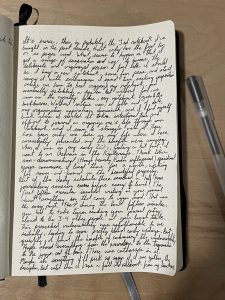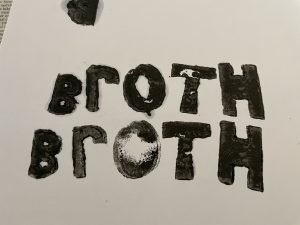Handwriting

As a remote, tech-adjacent worker – 99.9% of my writing is done via typing. I have aspirations of filling pages of notebooks with journaling, organization, and planning, but I’ve never managed to make it stick. The most I write these days is in birthday and Christmas cards. As such I found the mechanical aspect of this task difficult, my writing muscles, as in the actual muscles in my fingers, out of shape. The discomfort reminiscent of madly scrawling out entire essays during finals in undergrad. From a content point of view, my writing flowed fairly smoothly as I translated my thoughts to the page.
As you can see, this translation was not without errors. But I naturally crossed things off and corrected my errors as I wrote. I’ve always leaned towards pens as opposed to pencils, as such, evidence of my mistakes are permanently marked on the page.
I think the most evident difference between writing by hand and writing via mechanical methods is intention and deliberation. Forms of writing such as typing are geared around efficiency, allowing users to quickly output large amounts of text with relative ease. Some forms, particularly digital, allow for seamless editing. This means everything a user writes is subject to change, imbuing the writing process with a sense of impermanence and constant, rapid change. In contrast, writing by hand is comparatively slow, even for a practised cursive writer. It also makes editing difficult, even when writing with pencil. I find that this forces me to slow-down and be intentional with my writing, spending more time thinking and reflecting on what I am recording.
Potato Stamps

The most challenging part of the potato stamp exercise was the carving. I have never done any amount of carving in my life, thus this proved to be a test of dexterity and patience. I only almost cut myself once.
It ended up taking me nearly an hour to carve the five stamps, between sourcing the materials, preparing the workspace (newspaper, bowl, knife, paintbrush), and doing the carving and application. I knew it would take a while.
I chose the word broth – a common word I use to start of Wordle with. What I didn’t take into consideration is how difficult it would prove to be to carve the two holes in the “B” and the hole in the “O”. My second “O” is particularly rough, as I forgot to re-apply paint in-between stamping.
You will note that my “r” is lowercase – this was not an artistic decision on my part, but an attempt at reducing the butchery that resulted when needing to carve out another hole, which would be needed in the uppercase “R”. The “T” was by far the easiest, with its relatively uniform lines and lack of curves, while the “B” was tedious due to its curves and holes.
The exercise of creating a potato stamp exposes the deceiving simplicity of the mechanization of text. It seems simple – carve out each letter and use it repeatedly to create text. Not only is the creation of each stamp an undertaking, but the application requires precision and care. There are clear differences between my two words – discrepancies which would take enormous attention to reduce. The representation of each letter has to be carefully evaluated and adjusted to ensure its compatibility with the mechanical medium. I believe these differences could cause two copies of the same text to be interpreted differently. It makes one appreciate the enormous feat that early writing mechanization represented.
Leave a Reply